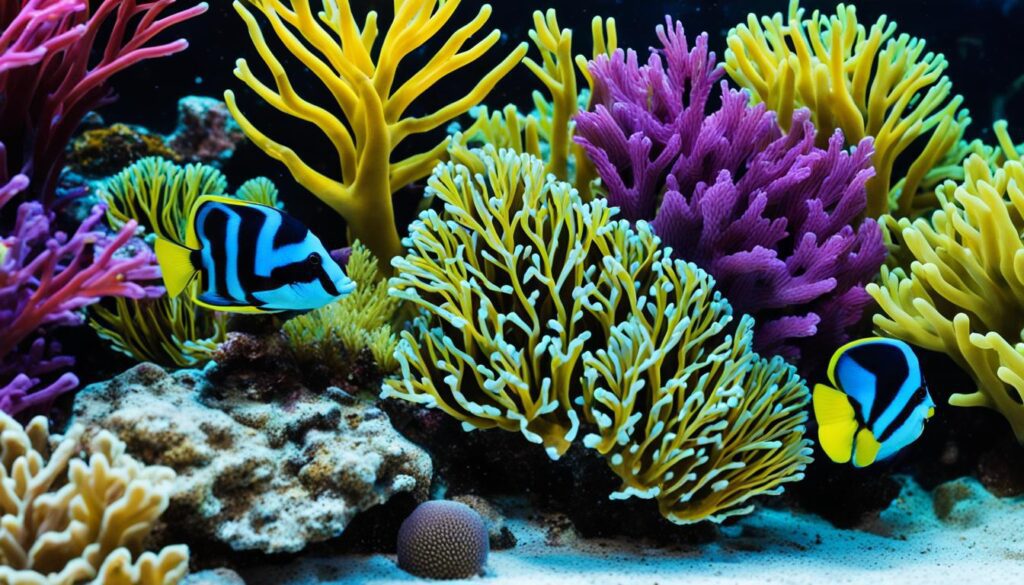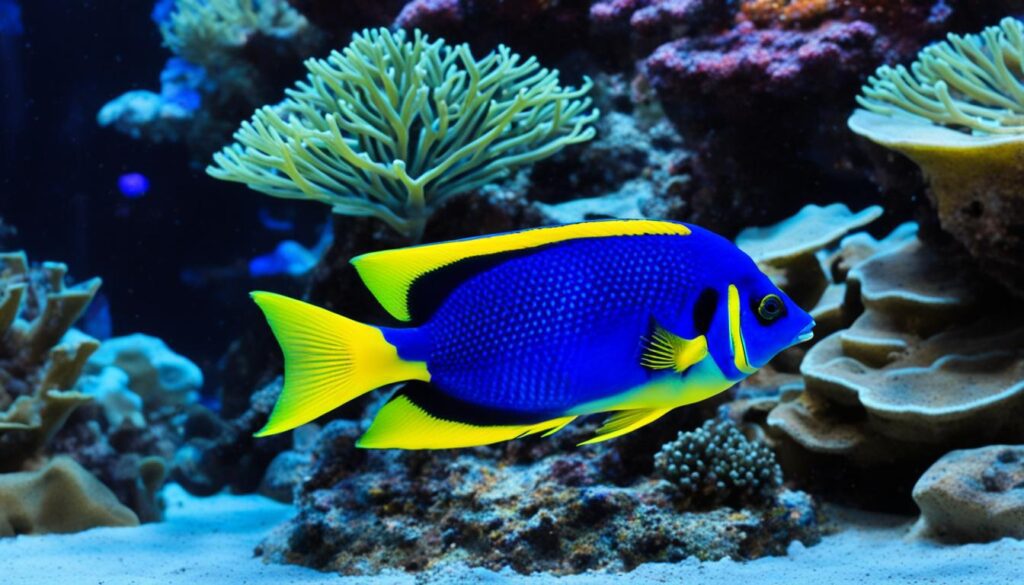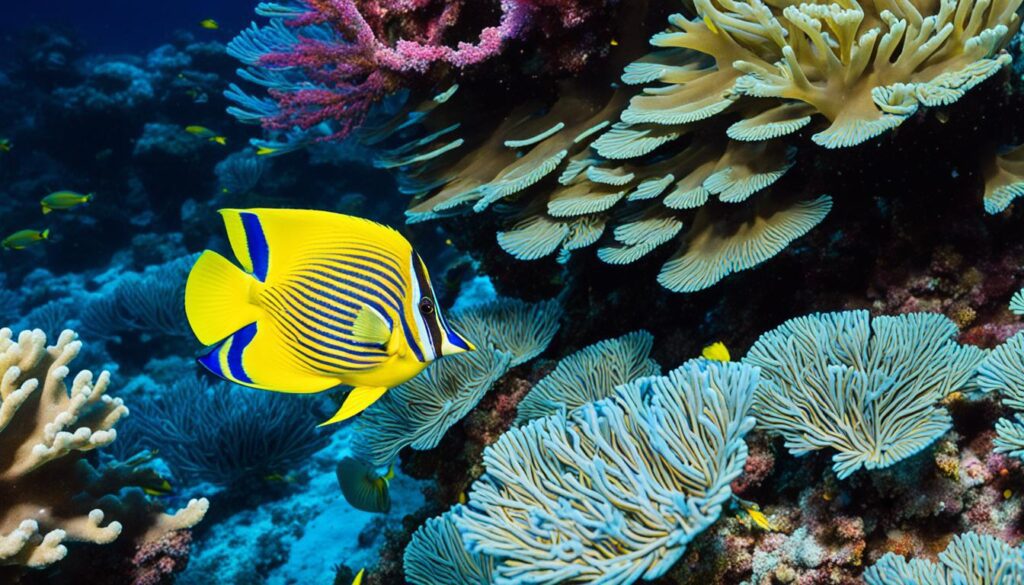The chevron tang is a jewel of the sea. It changes color as it grows. This fish, known as Ctenochaetus hawaiiensis, adds magic to any tank. They live in the huge ocean area from Hawaii to the entire Pacific. There, they move quickly and catch everyone’s eye.
Eating algae is one way these fish keep their home clean, which is why they are highly regarded in aquariums. I discovered how important it was to know and maintain them well. My tank has shown that proper planning is worth it. The room is spacious and sea-like, providing an ideal habitat for the fish.
When given a suitable tank and friends, chevron tangs can reach 7 inches long. They have beautiful looking stripes running through their body. In a properly designed tank, they become the focal point. It’s not only maintaining them alive but making sure they are contented ones.
Seeing these fish go from young to adult in a well-set tank is amazing. A good aquarium is like a piece of art with fish as the stars. I’ll help you make your tank great, just like mine.
Identification of Chevron Tangs

The Chevron Tang’s allure starts with its vivid color changes, crucial for identifying them. Young Chevron Tangs show off an orange body with electric blue lines. These brilliant colors help both enthusiasts and scientists recognize them.
With age, they change remarkably. The bright orange fades to a deep orange-red, offset by dark lines. As adults, they can turn nearly black, with the color depth varying by their surroundings and what they eat.
Color Transformation from Juvenile to Adult
Changing colors is key to knowing a Chevron Tang’s age and health. From vibrant young fish to darker adults, each stage tells us about their well-being. This info helps aquarium owners keep their tanks just right for these beautiful fish.
Distinguishing Features for Identification Purposes
Chevron Tangs aren’t just known for their colors. They have a unique fan-shaped body and can grow up to 10 inches long. They need big tanks to stay healthy and swim freely.
A big aquarium, at least 135 gallons, is vital for them. This space lets them grow well and show off their stunning colors and behaviors.
Learning about Chevron Tangs’ size and color is truly interesting. It shows the importance of detail in fish care and study. Their unique look not only makes aquariums prettier but also helps us appreciate marine life more.
Tank Setup for Chevron Tangs

Creating the perfect tank setup for a chevron tang means knowing their wild home. These fish like sloping reefs and lively waters. So, their tank should have lots of oxygen, plenty of water movement, and a sandy bottom. Don’t forget the live rock. It helps grow the algae they eat.
To make a tank like their natural habitat, start with at least 75 gallons. That’s what chevron tangs need to swim and look for food comfortably. Big tanks help them stay active and happy. This can keep them from getting stressed and sick.
Requirements |
|
|---|---|
Minimum Tank Size |
75 gallons |
Water Temperature |
73-80°F (23-27°C) |
pH Level |
8.1-8.4 |
Dissolved Oxygen |
High |
Setup Type |
Reef Compatible |
Besides size and clean water, your chevron tang tank needs a strong water flow. It mimics their natural ocean homes and keeps oxygen levels high. This is key for their health.
Keeping these conditions, watching the tank closely, and making changes when needed will help your chevron tang do more than just live. They’ll shine in your tank, showing off their beauty and unique ways. It makes them a great addition to any saltwater aquarium.
The Diet of a Chevron Tang

The chevron tang is most healthy when it eats like it would in the ocean. It’s not just about keeping them alive. It’s about creating a lively, healthy aquarium that shows the beauty of the sea.
Algae: The Natural Food Source for Chevron Tangs
The main food for chevron tangs is marine algae. They have special teeth for eating micro-algae from rocks and coral. By feeding them algae, you make their tank like their ocean home. This keeps them healthy and the tank clean by controlling algae growth.
Supplemental Foods for A Balanced Diet
To keep their diet varied, add other foods to their meals. Nori seaweed is good for them. Sometimes, you can give them mysis shrimp. Though shrimp don’t offer much nutrition, they are like the proteins tangs sometimes eat in the wild.
Feeding Element |
Frequency |
Benefits |
|---|---|---|
Marine Algae/Nori Seaweed |
Daily |
Main diet, mimics natural grazing |
Mysis Shrimp |
Twice per week |
Provides occasional protein |
Watching the water quality is important for chevron tangs’ health. A well-fed tang helps keep the ecosystem balanced. It eats harmful algae and keeps the aquarium looking good.
Feeding your chevron tang this way ensures it doesn’t just survive, but thrives. Your aquarium will have more color and life, thanks to your care.
Chevron Tang Health and Wellness
Keeping chevron tang health at its best is key for their long life and happiness. It’s important to prevent diseases and treat them well. By making sure their living conditions are perfect, owners can make their chevron tangs much healthier.
Check the water often to keep it just right. The ideal temperature is between 77-80°F. Nitrates should always be at 0. Changing the water, about 10% every two weeks, helps keep everything balanced.
A good diet is crucial for chevron tang health. Feeding them Mysis shrimp, brine shrimp, Spirulina, and pellets with garlic is beneficial. Garlic is especially good for fighting diseases like Ich, which causes white spots and twitching.
If fish get sick, acting fast with treatment is key. Using quarantine tanks and medications like formalin or copper can help. It’s also good to use natural remedies and reduce stress to help them heal.
- Quarantine tanks: Set up a separate tank for sick fish to stop diseases from spreading.
- Medication: Use formalin or copper treatments safely.
- Natural supplements: Add garlic to food to help boost their immune system.
- Stress reduction: Make sure there are plenty of hiding spots and keep the environment calm.
To sum up, the well-being and long life of chevron tangs depend on regular health checks, managing their environment, early disease prevention, and quick treatment. Following these steps will help aquarists keep their chevron tangs happy and healthy.
Chevron Tang Compatibility & Tank Mates
When you add a Chevron Tang to your aquarium, thinking carefully about their tank mates is key. The ocean-like setting and the fish’s bright colors make it very desirable. However, these peaceful-looking fish might have difficulty getting along with others.
Tank mates must be chosen with the chevron tang’s behavior in mind. They usually get along with corals and invertebrates. But, they might not do well with fish that eat the same food or look similar. Fish like Dwarf Angels or other tangs may either cause or face aggression.
Understanding Aggressive Behaviors
Such aggressive behaviors are often about territory and competing for food. This is common in many fish but can be more intense in tanks. To avoid fights, it’s best to keep only one Chevron Tang. This helps them live peacefully with other tank mates who stay out of their space.
Who Can Coexist with Chevron Tangs?
Picking the right tank mates for your chevron tang means thinking about diet and living conditions. Choose fish that are not territorial and do not fight over food. Surgeonfish can be good companions with careful monitoring. Check out ways to manage tang aggression for peaceful living tips.
Species |
Compatibility |
Notes |
|---|---|---|
Desjardini Sailfin Tang |
Low |
Requires significantly larger tank, potential for competition. |
Purple Tang |
Medium |
Similar dietary needs, best in larger tanks. |
Clown Tang |
Low |
Highly territorial, not recommended for mixed species tanks. |
For peace in the tank, keep a close watch and tweak conditions as needed. Knowing each fish’s habits and needs is vital. Creating a happy tank community means every fish can act naturally and stay healthy.
Water Requirements and Parameters for Chevron Tangs
To keep chevron tangs healthy, knowing and managing their water needs is crucial. It’s important to make their tank environment mimic their natural habitat. This helps create a stable and healthy living space for them.
Maintaining Optimal Water Quality
High-quality water is a must for chevron tangs. Use a strong filtration system and change the water regularly. Clean water boosts their health, showing off their bright colors and lively nature. It’s also key to test for nitrates, ammonia, and other pollutants often.
Focus on keeping the water chemically balanced. Regular tests help find and fix any issues quickly. This reduces stress and disease risks for the fish.
Temperature and pH Levels
Chevron tangs do best in water that’s 72 to 78 degrees Fahrenheit. Keep this temperature steady to avoid stressing them out. The pH level should stay between 8.1 and 8.4 for their health.
To keep chevron tangs in tip-top shape, adjust the dKH between 8-12 for the right mineral content. Also, keep specific gravity at 1.020-1.025 to mimic their natural ocean environment. By following these guidelines, your chevron tangs will flourish, showing their natural beauty and behaviors.
Breeding and Lifespan
If you’re thinking about chevron tang breeding, there’s still much to learn. In the wild, they seem to pair up to spawn. But getting them to do this in a tank is tough. Capturing their natural breeding habits for aquarists and scientists is still a big challenge.
Now, let’s talk about how long chevron tangs can live. With the right tank care, they can live long and healthy lives. They do best when their tank mimics their natural home. Making sure they get the right food and water quality is key.
For health issues like fin problems or lockjaw, treatments are available. Yet, talking to a marine specialist is always a smart move. Chevron tangs need careful tank maintenance to thrive.
Too much stress, for example from long quarantine, is bad for them. It can lead to Ich, a common disease among these fish. A gentle move to their main tank is critical. While they may not live as long as some tangs, they can still be a joy to have. With attention and care, they make great aquarium inhabitants.








